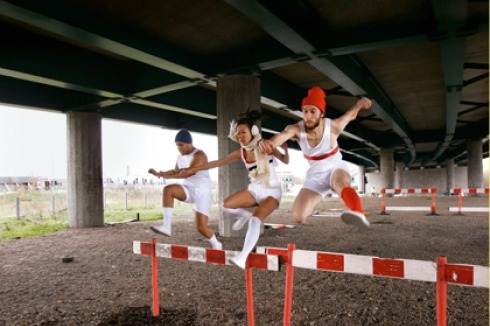Gold for London?
Editorial
Text: Schultz, Brigitte, Berlin; Meyer, Friederike, Berliln
Gold for London?
Editorial
Text: Schultz, Brigitte, Berlin; Meyer, Friederike, Berliln
The legacy of the Olympic Games has become synonymous with oversized, grandiose arenas,
deserted parks and gentrified neighbourhoods. London urbanists are trying to break this vicious circle. From the outset their focus was on the time after the Games – using the mega-event as a catalyst for good place-shaping that ensures communities well beyond the Olympic Park fence can reap the rewards.
deserted parks and gentrified neighbourhoods. London urbanists are trying to break this vicious circle. From the outset their focus was on the time after the Games – using the mega-event as a catalyst for good place-shaping that ensures communities well beyond the Olympic Park fence can reap the rewards.
For a long time the Brits were one step ahead of us. Ever since the end of the 19th century, when the garden city movement spread from London to Hellerau, German planners have looked at the work of their colleagues from the island with curiosity bordering on envy. In the 1980s London made an excellent job of ruining its progressive reputation through the politics of the Thatcher Government, which needlessly abandoned the field to market forces, and large-scale projects such as the Docklands, which after a short period as a shining example, was soon regarded as a “totally misunderstood challenge” (Stadtbauwelt 1988). This year, London wants to convince the world that much has changed. Through the Olympic megaproject the city has developed a strategy aimed at setting new standards in the planning of major events of this kind.
What remains after the Games
A term heard throughout London these days is “Olympic Legacy” – meaning the aftermath of the Olympic Games. In view of the numerous derelict sites across the globe that bear witness to the short-term hunger for land for cultural and sporting events and the subsequent helplessness in disposing of them, the London authorities planned the proverbial “legacy” of their major sporting event at an earlier stage than others. And not only that: from the outset the Games were conceived as a miracle cure for one of the poorest areas of Western Europe, London’s East End. The 200-hectare Olympic Park is embedded in residential neighbourhoods which were badly disfigured by a period of deindustrialisation.
Whereas one tower block after another competes to dominate London’s city skyline, the Olympic Park appears rather unspectacular. Aside from Zaha Hadid, who was selected to design the aquatics centre, the responsible planning authorities decided to forego the big names. Many competition venues are temporary and constructed of standardised steel parts which can be re-used after the Games. Apart from large-scale blunders such as the faceless Olympic Village, which is located adjacent to a huge mall, on the whole the resulting architecture is pragmatic in an entirely positive sense. Amid a climate of austerity and radical cuts to social programmes, they avoided the impression that public funds were being wasted on architectural extravagances. On the other hand a clear emphasis has been placed: the architecture is secondary to the urban plan. The priority for the Olympic Park was its integration into the existing urban structure of East London.
Besides the planned legacy of the Olympic Park, which strives to rein in market forces and enliven the park with intermediate uses, the treatment of the so-called “fringe” is particularly noteworthy. Here, the urban planners are endeavouring to upgrade the neighbourhoods bordering the park, working collaboratively with local residents. They were called in, by the London Legacy Development Corporation (LLDC) amongst others, who are responsible for the urban planning legacy of the Games. Eleanor Fawcett, Head of Design at the LLDC, prepared a walk around the park for us. It led to many projects already underway: street furniture, new paths and even individual buildings – all minor improvements which reveal their full potential when seen as a whole. They are aimed at strengthening the communities around the Olympic Park, maintaining neighbourhood identity and counteracting any potential displacement.
The design of the Olympic fringe was entrusted to a series of good, mainly very small London architecture practices – a strategy which has been pursued for the past five years by Design for London, the Mayor of London’s architecture and urbanism team. We visited five of them. They explained how they learned from Hansel and Gretel, what is to be understood by the phrase “Stitching the fringe”, and why they are building a house for a long-deceased poet. We talked about the difference between British and German planning mentality and the difficulties involved in laying out a three-mile long park. Many of their projects make it clear that good urban planning can sometimes be almost invisible and frequently short-lived – and that urban planners are often more in demand as facilitators than as designers.
It is hoped that London will continue to pursue the design and planning strategies developed for the Olympics, particularly in their reaction to the social disturbances in 2011 and Crossrail, Europe’s largest railway construction project, which will traverse the city from east to west in 2018. We believe these concepts have what it takes to be exemplary. Once again, it’s time to be inspired by London.








0 Kommentare